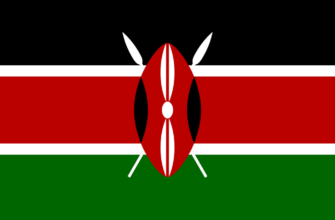The Republic of Rwanda is an East African state with a territory of 26.3 thousand square kilometers and a population of 12.4 million people. Before 1991 the country was called the Republic of Rwanda. The year of state formation is considered to be 1962, when the territory called Rwanda-Urundi was divided into two parts: Rwanda and Burundi.
This is what the modern flag of Rwanda looks like:

History of the flag
Rwanda remained a closed territory for a long time for the colonial European powers. They first entered the land in 1892 as a result of the Brussels Conference of 1890, which placed the territory under the protectorate of the German Empire (the Second Reich). At first, the country was ruled by the German East Africa Company, which was later acquired by the German government. This colonial territory included in addition to Rwanda the territories of Burundi and Tanzania.

At that time the flag of the colonial empire was a black-white-red cloth with a coat of arms in the center.

Shortly before the outbreak of World War I, a new banner was designed for East Africa, which was never used, because after the war part of its territory came under Belgian control and received the new name of Rwanda-Urundi.

The Belgian symbolism was used as a symbol.

In the 1950s, Belgium began to implement reforms that led to resistance among the local tribes (Tutsi, Hutu). This later developed into a movement for independence. The 1959-1961 revolution overthrew the kingdom of Rwanda and in 1962 the country was proclaimed a republic. In 59-61 the tricolor with vertical red-yellow-green stripes was used as the flag.

In 61-62, the same symbol, with the red and green places rearranged.

In July 1962 a new symbol of Rwanda was adopted, repeating the tricolor of 59-61, only the Latin letter «R» was added to the yellow stripe to distinguish it from the flag of Guinea.
The modern form of the symbol was adopted in October 2001.
Description
The symbol of Rwanda is a rectangular cloth with an aspect ratio of 2 to 3. It is divided into three horizontal stripes, of which the blue one (top) occupies half the width of the flag and the other half is equally divided between the yellow and green stripes.
On the opposite side of the banner on the blue part of the symbol is a yellow sun.
The colors of the Rwandan flag
The flag of the Republic is performed using three colors: blue, yellow, and green
Meaning of colors and flag symbol
The colors and symbols on the flag symbolize:
- yellow — gold and other natural resources of the country;
- green — vegetation, tropical forests, prosperity;
- blue — rivers and Lake Kivu, happiness, peace and clear skies over the country.
The sun in the blue sky symbolizes hope for a bright future for the Republic.
Rwanda’s new flag symbolizes national unity, heroism, and confidence in tomorrow. The change in the appearance of the flag was dictated by the desire to turn the dark history of the 1994 civil war and genocide upside down.
Other Flags
Despite the short existence of a sovereign state, the Republic has other types of symbols and emblems. Among them are:
- Presidential;

- The defense force, which includes land and air forces.

General information about Rwanda
| Official language | Kinyarwanda, English, French, and Swahili |
| Capital | Кигали |
| Territory | 26,338 km² |
| Population | 12,374,397 people |
| Currency | Rwandan franc |
| Phone Code | +250 |










Как женщина, я хочу отметить, что флаг Руанды является символом единства и надежды для страны. Его яркие цвета — голубой, желтый и зеленый — отражают культурное наследие и природные богатства Руанды. Этот флаг напоминает нам о пути, который прошла нация после трудных времен, и о важности сплоченности и мира. Равенство возможностей для всех граждан и развитие государства — это то, к чему должна стремиться любая нация.
Согласен с вами! Когда я путешествовал по Африке, увидел, как люди гордятся своим флагом. Это действительно вдохновляет. Как и в вашей стране, единство и надежда важны для всех, и я верю, что каждый шаг к равенству делает нас сильнее.
Абсолютно согласен! Флаг действительно символизирует надежду и единство. Когда я путешествовал по Руандe, увидел, как жители гордятся своим наследием. Это вдохновляет! Важно, чтобы каждый чувствовал себя частью одной большой семьи, независимо от сложностей.
Я тоже согласен! Когда я был в Греции, местные жители с гордостью рассказывали о своем флаге и истории. Это создает невероятное чувство единства. Каждая культура приносит что-то уникальное, и вместе мы действительно сильнее. Надо беречь это чувство!
Я тоже так думаю! Когда я была в Италии, видела, как местные жители с гордостью показывают свои традиции. Это действительно создает чувство общности. Каждый из нас, даже в трудные времена, может найти поддержку в культуре и традициях своего народа.
Согласен, флаг объединяет. Когда я в волонтёрском проекте в постконфликтной зоне работал, символы и церемонии помогли восстановить инклюзию и социальный капитал. — Эдвард